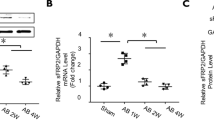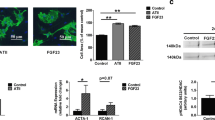Abstract
Secreted frizzled-related protein 5 (sFRP5) is a novel adipokine that functions as an inhibitor of Wnt signaling and is involved in embryonic development, proliferation, atherosclerosis, and apoptosis. Studies have shown that sFRP1-4 is expressed in cardiomyocytes, and sFRP3 and sFRP4 are elevated during heart failure. However, it is unclear whether sFRP5 is expressed in cardiomyocytes or cardiac hypertrophy, and as regards the effects of sFRP5 in the process. Here, we report the expression and the corresponding mechanisms of sFRP5 in angiotensin II (Ang II)-induced cardiomyocyte hypertrophy. Neonatal rat ventricular myocytes were exposed to increasing concentrations of Ang II for 12–72 h. Y27632 was used to block ROCK signal. PD98059, SB203580, and SP600125 were used to inhibit ERK1/2, p38 MAPK, and JNK signaling pathways, respectively, and anisomycin was used to activate JNK pathway. RT-PCR and Western-blot determined the expressions of sFRP5. BNP, TNF-α, ROCK1, ROCK2, MYPT1, and JNK were examined through Western-blot analysis. Ang II increased sFRP5 mRNA and protein levels in a time- and dose-dependent manner. Telmisartan, Y27632 and SP600125 effectively suppressed the expression of sFRP5. sFRP5 downregulated BNP and TNF-α expressions in hypertrophic cardiomyocytes. sFRP5 is expressed in cardiomyocytes, and upregulated in Ang II-induced cardiomyocyte hypertrophy through the AT1 receptor/Rho/ROCK1/JNK signaling pathway. sFRP5 may play an important role during cardiomyocyte hypertrophy.






Similar content being viewed by others
References
Kai H (2006) Cardiac remodeling in chronic heart failure. Nihon Rinsho 64:855–860
Rosenbaugh EG, Savalia KK, Manickam DS, Zimmerman MC (2013) Antioxidant-based therapies for angiotensin II-associated cardiovascular diseases. Am J Physiol Regul Integr Comp Physiol 304:R917–R928
Makino N, Sugano M, Otsuka S, Hata T (1997) Molecular mechanism of angiotensin II type I and type II receptors in cardiac hypertrophy of spontaneously hypertensive rats. Hypertension 30:796–802
ter Horst P, Smits JF, Blankesteijn WM (2012) The Wnt/frizzled pathway as a therapeutic target for cardiac hypertrophy: where do we stand? Acta Physiol (Oxf) 204:110–117
Dawson K, Aflaki M, Nattel S (2013) Role of the Wnt-frizzled system in cardiac pathophysiology: a rapidly developing, poorly understood area with enormous potential. J Physiol 591:1409–1432
Almario RU, Karakas SE (2015) Roles of circulating WNT-signaling proteins and WNT-inhibitors in human adiposity, insulin resistance, insulin secretion, and inflammation. Horm Metab Res 47:152–157
Nakamura K, Fuster JJ, Walsh K (2014) Adipokines: a link between obesity and cardiovascular disease. J Cardiol 63(4):250–259
Schumann H, Holtz J, Zerkowski HR, Hatzfeld M (2000) Expression of secreted frizzled related proteins 3 and 4 in human ventricular myocardium correlates with apoptosis related gene expression. Cardiovasc Res 45:720–728
Qi M, Elion EA (2005) MAP kinase pathways. J Cell Sci 118:3569–3572
Lakshmanan AP, Harima M, Sukumaran V, Soetikno V, Thandavarayan RA, Suzuki K, Kodama M, Nagata M, Takagi R, Watanabe K (2012) Modulation of AT-1R/AMPK-MAPK cascade plays crucial role for the pathogenesis of diabetic cardiomyopathy in transgenic type 2 diabetic (spontaneous diabetic torii) rats. Biochem Pharmacol 83(5):653–660
Hagenmueller M, Riffel JH, Bernhold E, Fan J, Zhang M, Ochs M, Steinbeisser H, Katus HA, Hardt SE (2013) Dapper-1 induces myocardial remodeling through activation of canonical Wnt signaling in cardiomyocytes. Hypertension 61:1177–1183
Hlubek F, Spaderna S, Schmalhofer O, Jung A, Kirchner T, Brabletz T (2007) Wnt/FZD signaling and colorectal cancer morphogenesis. Front Biosci 12:458–470
Jaikanth C, Gurumurthy P, Indhumathi T, Cherian KM (2014) Emergence of sfrp5 as a pleiotropic adipocytokine and its association with Wnt signaling. Minerva Endocrinol [Epub ahead of print]
Ouchi N, Higuchi A, Ohashi K, Oshima Y, Gokce N, Shibata R, Akasaki Y, Shimono A, Walsh K (2010) Sfrp5 is an anti-inflammatory adipokine that modulates metabolic dysfunction in obesity. Science 329:454–457
Carstensen M, Wiza C, Röhrig K, Fahlbusch P, Roden M, Herder C, Ouwens DM (2014) Effect of Sfrp5 on cytokine release and insulin action in primary human adipocytes and skeletal muscle cells. PLoS One 9:e85906
Miyoshi T, Doi M, Usui S, Iwamoto M, Kajiya M, Takeda K, Nosaka K, Nakayama R, Okawa K, Takagi W, Nakamura K, Hirohata S, Ito H (2014) Low serum level of secreted frizzled-related protein 5, an anti-inflammatory adipokine, is associated with coronary artery disease. Atherosclerosis 233:454–459
Guo B, Li Y, Han R, Zhou H, Wang M (2011) Angiotensin II upregulation of cardiomyocyte adiponectin production is nitric oxide/cyclic GMP dependent. Am J Med Sci 341:350–355
Carstensen M, Herder C, Kempf K, Erlund I, Martin S, Koenig W, Sundvall J, Bidel S, Kuha S, Roden M, Tuomilehto J (2013) SFRP5 correlates with insulin resistance and oxidative stress. Eur J Clin Invest 43:350–357
Akazawa H, Komuro I (2012) Mechanisms underlying angiotensin II-independent activation of angiotensinII type 1 receptor. Nihon Rinsho 70:1492–1498
Matsubara H, Mori Y, Masaki H, Inada M (1998) Pathophysiological function of angiotensin II AT1 and AT2 receptors and clinical application of AT1 antagonists. Nihon Rinsho 56:1912–1918
Wang X, Lu J, Khaidakov M, Mitra S, Ding Z, Goyal T, Mehta JL (2012) Delineation of the effects of angiotensin type 1 and 2 receptors on HL-1 cardiomyocyte apoptosis. Apoptosis 17:908–915
Balakumar P, Jagadeesh G (2014) A century old renin-angiotensin system still grows with endless possibilities: AT1 receptor signaling cascades in cardiovascular physiopathology. Cell Signal 26:2147–2160
Ohtsu H, Mifune M, Frank GD, Saito S, Inagami T, Kim-Mitsuyama S, Takuwa Y, Sasaki T, Rothstein JD, Suzuki H, Nakashima H, Woolfolk EA, Motley ED, Eguchi S (2005) Signal-crosstalk between Rho/ROCK and c-Jun NH2-terminal kinase mediates migration of vascular smooth muscle cells stimulated by angiotensin II. Arterioscler Thromb Vasc Biol 25:1831–1836
Ocaranza MP, Rivera P, Novoa U, Pinto M, González L, Chiong M, Lavandero S, Jalil JE (2011) Rho kinase inhibition activates the homologous angiotensin-converting enzyme-angiotensin-(1-9) axis in experimental hypertension. J Hypertens 29:706–715
Liu PY, Liao JK (2008) A method for measuring Rho kinase activity in tissues and cells. Methods Enzymol 439:181–189
Zhang YM, Bo J, Taffet GE, Chang J, Shi J, Reddy AK, Michael LH, Schneider MD, Entman ML, Schwartz RJ, Wei L (2006) Targeted deletion of ROCK1 protects the heart against pressure overload by inhibiting reactive fibrosis. FASEB J 20:916–925
Rose BA, Force T, Wang Y (2010) Mitogen-activated protein kinase signaling in the heart: angels versus demons in a heart-breaking tale. Physiol Rev 90:1507–1546
Acknowledgments
This work was supported by Grants from The Nature Science Foundation of Hebei Province (Grant No. H2014206389).
Author information
Authors and Affiliations
Corresponding author
Rights and permissions
About this article
Cite this article
Jin, X., Guo, B., Yan, J. et al. Angiotensin II increases secreted frizzled-related protein 5 (sFRP5) expression through AT1 receptor/Rho/ROCK1/JNK signaling in cardiomyocytes. Mol Cell Biochem 408, 215–222 (2015). https://doi.org/10.1007/s11010-015-2497-9
Received:
Accepted:
Published:
Issue Date:
DOI: https://doi.org/10.1007/s11010-015-2497-9




